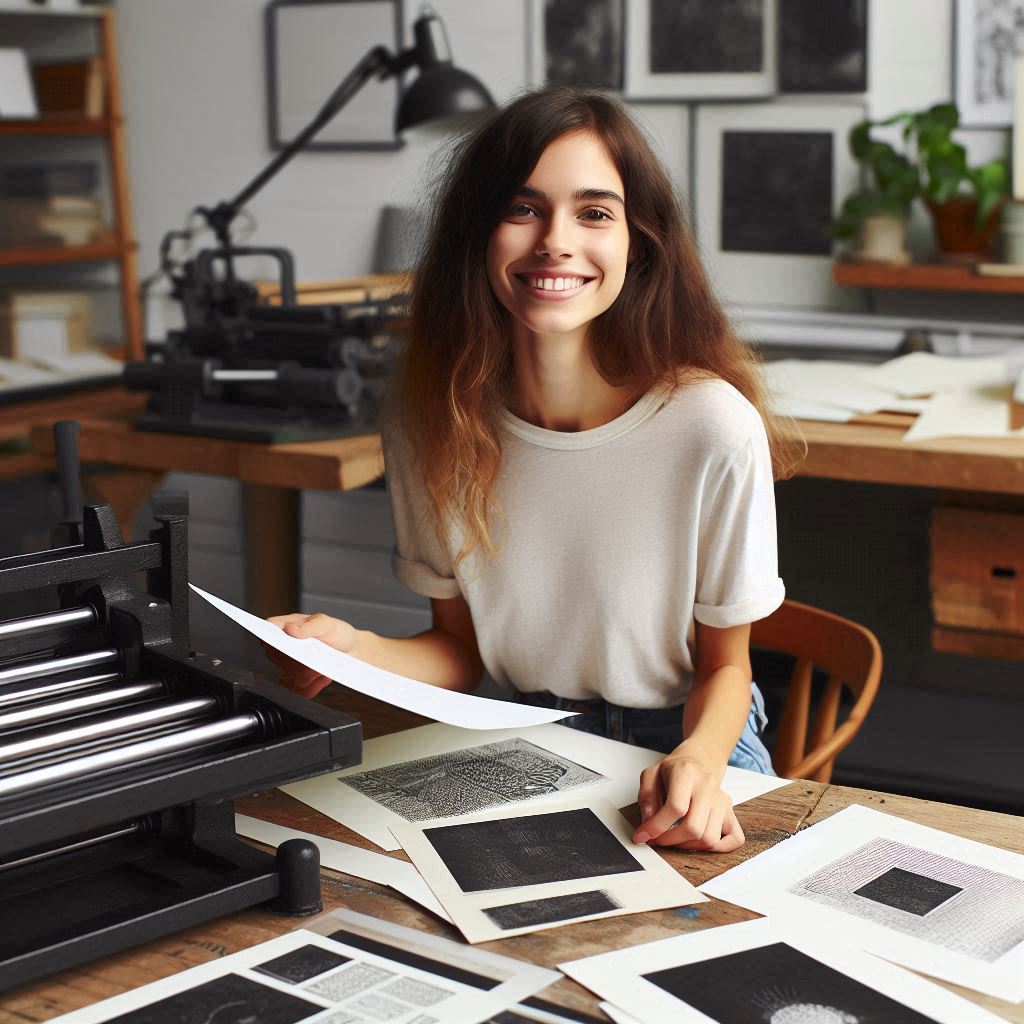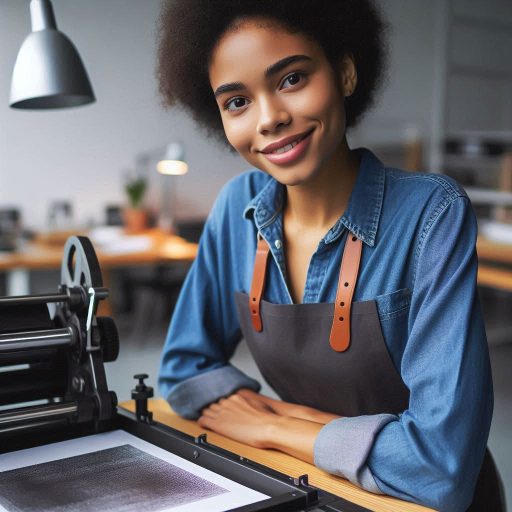Introduction
Choosing the right paper for printmaking is essential to achieving quality results.
The type of paper you select affects the texture, clarity, and overall appearance of your print.
Printmakers often spend time considering the characteristics of various papers to ensure they complement their specific techniques.
For example, some papers are better suited for relief printing, while others are ideal for intaglio or lithography.
The thickness, texture, and absorbency of the paper all influence how ink adheres and transfers.
A well-chosen paper enhances the print’s fine details, allowing it to stand out.
Poor paper selection, however, can cause ink smudging or uneven lines, detracting from the work.
The paper’s weight also determines how well it holds up during printing.
Lighter paper may tear under pressure, while heavier paper provides stability.
Surface texture is equally important; a rough texture creates a more expressive image, while smooth paper supports crisp lines and precision.
Ultimately, the right paper choice directly impacts the final outcome of the print.
A thoughtful decision enhances the overall look, durability, and feel of the piece, helping printmakers achieve their artistic vision.
When selecting paper, always consider the specific needs of your project to achieve the best results.
Understand the different Types of Paper
When it comes to printmaking, choosing the right paper is crucial.
There are several types of paper options available, each with its own unique characteristics that can significantly impact the final outcome of your print.
Watercolor Paper
Watercolor paper is a popular choice for printmaking due to its versatility.
It comes in various weights, textures, and finishes, allowing artists to experiment with different techniques.
The texture of watercolor paper varies from rough to smooth, providing artists with options to create different effects in their prints.
Watercolor paper is highly absorbent, making it suitable for techniques that involve a lot of moisture.
It is important to consider the weight of watercolor paper, as heavier weights are more durable and can withstand multiple layers of ink or paint.
Transform Your Career Today
Unlock a personalized career strategy that drives real results. Get tailored advice and a roadmap designed just for you.
Start NowPrintmaking Paper
Printmaking paper is specifically designed for printmaking techniques such as relief, intaglio, and lithography.
It is usually made from cotton or a blend of cotton and other fibers, which gives it strength and durability.
Printmaking paper has a smooth surface that is ideal for capturing fine details in prints.
It is available in various weights, with heavier weights being suitable for techniques that require multiple passes through a printing press.
Printmaking paper is resistant to tearing, creasing, and buckling, making it a reliable choice for professional artists.
Mixed Media Paper
Mixed media paper is a versatile option for printmakers who want to combine different techniques and materials in their prints.
It is usually thicker and more heavyweight than traditional drawing paper, allowing it to withstand wet media and multiple layers of ink or paint.
Mixed media paper has a medium texture that works well with a variety of mediums, making it suitable for experimental printmaking.
It is important to choose a mixed media paper that is compatible with the specific techniques and materials you plan to use in your prints.
Consider the absorbency and weight of mixed media paper to ensure it meets the requirements of your printmaking process.
Understanding the differences in texture, weight, and absorbency of each type of paper is essential for selecting the right paper for your printmaking projects.
By choosing the appropriate paper, you can enhance the overall quality and longevity of your prints.
Read: The Future of Printmaking in Digital Age
Consider the Quality of the Paper
When it comes to choosing the right paper for printmaking, the quality of the paper plays a crucial role in the outcome of the print.
Here are some key points to consider:
Importance of using acid-free paper
- Acid-free paper is essential for the longevity and preservation of the print.
- It helps prevent yellowing and deterioration of the paper over time.
- Using acid-free paper ensures that your prints will last for generations to come.
Durability and strength of the paper
- The durability of the paper is important as it affects how well it holds up during the printing process.
- Choose a paper that can withstand the pressure and moisture involved in printmaking.
- Thicker papers tend to be more durable and less prone to tearing or warping during printing.
- Consider the weight of the paper, as heavier paper is generally stronger and more resistant to damage.
By paying attention to the quality of the paper you use for printmaking, you can ensure that your prints turn out beautifully and have a longer lifespan.
Choose acid-free paper for preservation and opt for a durable, strong paper that can withstand the printing process for the best results.
Read: Printmaking Techniques: Woodcut and Linocut
Choose the Appropriate Surface Finish
When choosing the right paper for printmaking, it is crucial to consider the surface finish of the paper you will be using.
The surface finish can significantly impact the final look and feel of your print.
Transform Your Career Today
Unlock a personalized career strategy that drives real results. Get tailored advice and a roadmap designed just for you.
Start NowThere are three main types of paper surface finishes: hot-pressed, cold-pressed, and rough.
Hot-Pressed Paper
Hot-pressed paper has a smooth and flat surface with minimal texture.
This type of paper is ideal for detailed and precise work, such as pen and ink drawings or highly detailed prints.
The smooth surface allows for crisp lines and fine details to be captured accurately.
The lack of texture also makes it easier to control the application of ink or paint, resulting in a clean and professional finish.
Cold-Pressed Paper
Cold-pressed paper has a slightly textured surface that is versatile and suitable for a wide range of printmaking techniques.
The texture of cold-pressed paper adds a subtle dimension to prints, creating a more organic and natural look.
This type of paper is commonly used for watercolor and gouache paintings, as the texture helps to enhance the brushstrokes and adds depth to the final piece.
Cold-pressed paper is also popular for relief printing, such as linocuts or woodcuts, as the texture can add interest and character to the print.
Rough Paper
Rough paper has a highly textured surface that adds a distinctive and expressive quality to prints.
The rough texture of this paper can create dramatic effects, especially when using media with a more fluid consistency, such as watercolor or ink washes.
Prints created on rough paper often have a more tactile and handmade appearance, making them stand out and grab the viewer’s attention.
Rough paper is commonly used for expressive and experimental printmaking techniques, as the texture can enhance the overall aesthetic of the print.
In fact, the surface finish of the paper you choose for printmaking can greatly influence the appearance and texture of your final prints.
Consider the level of detail, type of media, and overall aesthetic you are aiming for when selecting the appropriate surface finish for your project.
Experimenting with different types of paper can help you discover new possibilities and enhance your artistic expression through printmaking.
Read: The Impact of Public Art Sculptures on Communities

Select the Right Weight of Paper
When it comes to choosing the right paper for printmaking, one crucial factor to consider is the weight of the paper.
Paper weight is measured in pounds per ream (500 sheets) and can greatly influence the outcome of your prints.
Exploring different paper weights
There is a wide variety of paper weights available for printmaking, ranging from 90 lb to 300 lb or more.
Transform Your Career Today
Unlock a personalized career strategy that drives real results. Get tailored advice and a roadmap designed just for you.
Start NowEach weight has its own unique characteristics and qualities that can affect the final result of your print.
Impact on overall feel and quality
The weight of the paper can have a significant impact on the overall feel and quality of the print.
Lighter weight papers, such as 90 lb, are more suitable for techniques like sketching or drawing, as they may not hold up well to heavy ink applications.
On the other hand, heavier weight papers, like 300 lb, are ideal for printmaking techniques that require multiple layers of ink or wet media.
They offer more durability and can withstand the pressure of printing presses without warping or buckling.
Choosing the right weight of paper for your printmaking project depends on the specific technique you plan to use and the desired outcome.
Experimenting with different paper weights can help you determine which one works best for your artistic vision and style.
Ultimately, the weight of the paper plays a crucial role in the success of your printmaking endeavors.
Read: Exploring Printmaking in Public Art Projects
Consider the Color of the Paper
When it comes to choosing the right paper for printmaking, there are several factors to consider.
One important factor is the color of the paper you choose.
The color of the paper can have a significant impact on the colors in the final print.
How the color of the paper can influence the colors in the print
The color of the paper you use can affect how the colors of the ink appear when printed on it.
For example, if you use a dark colored paper, the colors of the ink may appear darker and more muted compared to printing on a white paper.
This is because the color of the paper acts as a base layer that can interact with the ink colors.
Different effects of white, cream, and other colored papers on the final print
White paper
White paper is the most commonly used paper for printmaking.
It provides a neutral background that allows the colors of the ink to appear true to their original hue.
White paper works well for vibrant and colorful prints.
Cream paper
Cream paper has a warmer tone compared to white paper.
This can give the print a softer and more vintage look.
Transform Your Career Today
Unlock a personalized career strategy that drives real results. Get tailored advice and a roadmap designed just for you.
Start NowCream paper is often used for prints that have a nostalgic or old-fashioned feel.
Other colored papers
Using colored papers such as black, grey, or colored papers can add a unique twist to your prints.
These papers can create contrast with the ink colors and add depth and mood to the final print.
Experimenting with different colored papers can lead to unexpected and interesting results.
In general, the color of the paper you choose for printmaking can play a crucial role in determining the overall look and feel of your print.
Consider the effect you want to achieve and experiment with different colored papers to see how they can enhance your artwork.
Think About the Size of the Paper
Importance of choosing the right paper size based on the scale of the print
- Consider the importance of choosing the right paper size based on the scale of the print.
- Ensure that the paper size complements the intended size of your print.
- Choosing a paper size that is too small can limit your design options and creativity.
- On the other hand, selecting a paper size that is too large may result in wastage and increased cost.
Standard paper sizes for printmaking
The standard paper sizes used for printmaking are typically based on the ISO metric system.
Common sizes include A4, A3, A2, A1, and A0, with A0 being the largest and A4 the smallest.
These sizes are widely recognized and readily available, making them convenient for most printmaking projects.
When selecting a paper size, consider the dimensions of the image you intend to print.
Choose a size that provides enough space around the image for framing or mounting purposes.
For smaller prints, A4 or A3 sizes may be suitable, while larger prints may require A2, A1, or even A0.
Keep in mind that larger paper sizes may require special handling and equipment for printing and processing.
Consider the practical aspects of working with different paper sizes, such as storage and transportation.
Take into account the availability of paper in the selected size and ensure it fits your budget and printing requirements.
Experiment with Different Papers
When it comes to printmaking, the type of paper you use can make a significant difference in the outcome of your work.
Here are some reasons why you should experiment with different papers:
Encouraging readers to try out different types of paper
Each paper has unique textures and weights that can affect how the ink is absorbed and the overall look of the print.
Experimenting with different papers can help you find the perfect match for your printmaking style and technique.
Trying out various papers can also inspire creativity and push you to explore new possibilities in your artwork.
Transform Your Career Today
Unlock a personalized career strategy that drives real results. Get tailored advice and a roadmap designed just for you.
Start NowTips on how to test different papers
- Before committing to a final print, create small test prints on different papers to see how they handle the ink.
- Pay attention to how the paper absorbs the ink, how crisp the lines are, and how the colors appear on each type of paper.
- Take notes on the characteristics of each paper, such as its texture, thickness, and how it interacts with your printing technique.
- Don’t be afraid to mix and match papers to create unique effects and enhance the visual appeal of your prints.
By experimenting with different papers and testing them out before committing to a final print, you can elevate your printmaking process and create stunning artworks that truly stand out.
So go ahead, get creative, and see how different papers can transform your prints!
Conclusion
After exploring the various types of paper available for printmaking, it is evident that selecting the right paper is crucial to achieving the desired results.
The key points discussed include:
- Consider the weight and thickness of the paper to ensure it can withstand the printing process.
- Understanding the surface texture of the paper is essential for different printmaking techniques.
- Cotton paper is a popular choice for its durability, while handmade paper offers unique textures.
- Experimenting with different papers can lead to discovering new techniques and effects in printmaking.
- Ultimately, the right paper can enhance the overall quality and visual impact of your prints.
Choosing the appropriate paper for printmaking is more than just a technical decision—it is an artistic one that can significantly influence the outcome of your work.
By carefully selecting the right paper, you can elevate your printmaking process and achieve the desired results with precision and clarity.
Remember, the right paper is the foundation upon which your artistic vision comes to life.




